Pattabhi Jois only spoke broken English. He spent four years writing his only book - with the English translation following as long as 37 years later. As a student at the Sanskrit College at Mysore, he earned a meagre living by teaching yoga classes for his fellow students. Nevertheless, yoga always played the most important role in Pattabhi Jois's life. Whenever he entered the room, I immediately felt his enthusiasm for yoga practice and the motivation with which he wanted to share yoga with us pupils. A short look at the life of the guruji, as his pupils used to lovingly call him, is to help you get a deeper understanding.
The development of a practice system
With his students' financial help, Pattabhi Jois was able to purchase a small house with only two rooms Mysore's Lakshmipuram district in 1948. It was there that he founded the Ashtanga Yoga Research Institute, in short AYRI. Classes were taught in the living room. Pattabhi lived a simple, disciplined life, taught with great enthusiasm and worked long hours: classes started at 04.30 in the morning and, with the exception of days of the full moon and the new moon, he also taught classes in the evening. In his teaching, he focused on the therapeutic benefit of the exercises. Therefore, he paid great attention to the individual needs and conditions of his students and helped each single one develop their own, personal practice. Many renowned personalities from Mysore learned from Pattabhi and even doctors referred patients to him for yoga therapy.
In 1956, the financial situation of the Jois family finally improved. Pattabhi was given the rank of a professor at the Mysore Sanskrit College and also received better pay for his yoga classes there. Two years later, in 1958, he started writing a book with the title »Yoga Mala«, with mala translating into garland or prayer chain.
The positions of the practice system developed by Pattabhi Jois are structured like the beads of a mala. In this context, the breath serves as the connecting thread linking the positions, a phenomenon referred to as the so-called Vinyāsa system. The Yoga Mala was published in 1962 and, with only minimal deviations, describes the first practice series as it is still practised in Ashtanga Yoga today. It is called Yoga Cikitsa, which translates into yoga therapy.

How attention in the West turned to Pattabhi Jois
It was a small picture in one of many yoga books that was to start a revolution bringing Americans and Europeans to India to Pattabhi Jois and Ashtanga Yoga to the West. It was triggered by a visit by the Belgian André van Lysebeth Pattabhi Jois's small yoga school in Mysore in 1964. Drawing upon extensive previous knowledge in yoga and Sankskrit, he was highly interested in the practice system and spent two months with Pattabhi Jois. It is said that André learned the first and second series of Ashtanga Yoga during this time. The Second Series is called »Nāḍī Śodhana«, cleansing of the energy channels. Unfortunately, we don't know in how far the practice system learned by André corresponded to the second series established in Ashtanga Yoga today.
It was approximately at the same time that Pattabhi Jois expanded his small house to create a separate yoga room, where at least twelve students could practice and which freed him from having to use his living room for classes. Among the many books written by André van Lysebeth in the following years, one bears the title »Prāṇāyāma«; it was written directly after his time with Jois. The book also contains a picture of the guru, together with his name and his address. In this way, the name Pattabhi Jois slowly spread throughout the Western world but mainly in Europe. Among the first Westerners to travel to India to meet Pattabhi, many were Englishmen. In 1971, Pattabhi Jois left India for the first time. Following an invitation, he gave a talk in Sanskrit at an international yoga conference at Sao Paulo. Only two years later, in 1973, Pattabhi abandoned his professorship at the Mysore Sanskrit College to focus exclusively on teaching yoga.
Ashtanga Yoga's growing popularity
The first American to take yoga classes with Pattabhi Jois was Norman Allen in 1971. He attended a yoga demonstration at the Svāmī Gitananda Ashram in Pondicherry given by Manju Jois, Pattabhi's son. Impressed by what he had seen, he set out to learn this specific yoga system.
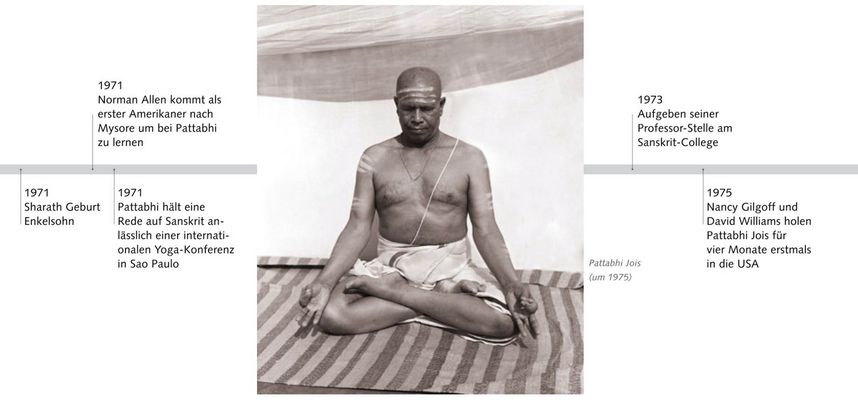
A little later, David Williams and Nancy Gilgoff arrived at the small Yoga Shala in Mysore. By his own account, David Williams was, after a little more than a year practising with Pattabhi Jois the first Westerner to master all practice series of Ashtanga Yoga in 1974. He was also the first teacher certified by Pattabhi Jois. The further series bear the name »Sthira Bhaga«, sublime serenity. They include progressive, physically challenging and athletic positions. These series underwent considerable further development in the later years of Pattabhi Jois's teaching. In contrast, there are only very few changes as far as the first two series are concerned.
It was also David and Nancy who invited Pattabhi Jois to come to California in 1975. Pattabhi Jois taught there for four months. This first workshop included only ten or 15 participants. A small start indeed, especially when you know how many people attended Pattabhi's later workshops. Pattabhi was accompanied on this journey by his son Manju Jois, who decided to stay in America to spread the traditional technique of Ashtanga Yoga there.
Time went by and Ashtanga Yoga gradually became more well-known in the Western world. Pattabhi Jois was invited to many workshops, not only in the US, but also in Brazil, England and many other countries. The numbers of his pupils started to increase and the early morning queue in front of the Yoga Shala in Lakshmipuram became longer and longer. The finishing sequence including the deep final relaxation was moved to a smaller room one floor higher. In doing so, room was made for the next practitioners. Rumour has it that Amma, the name lovingly given by Pattabhi's pupils to his wife, finally enforced that Saturdays were free from classes - like this, Pattabhi, in addition to the free days of the full and the new moon, had an additional day per week to spend with his family and to relax.
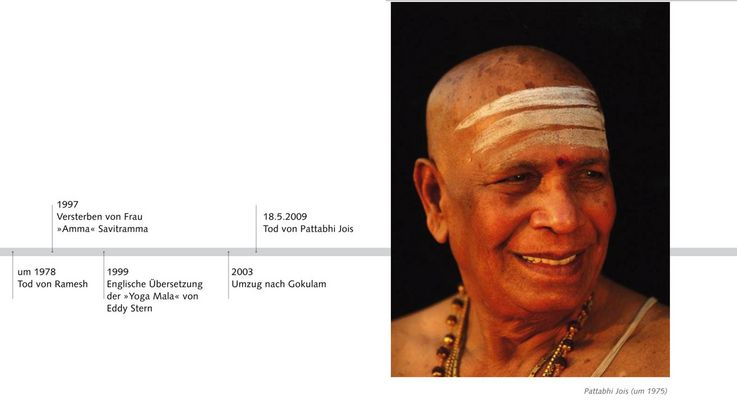
In 1978, Ramesh, Pattabhi's youngest son, dies. The death hits the family like a blow. There is few information about the concrete circumstances but there are rumours about a suicide. As a Hindu, Pattabhi abandoned the most important thing in his life on this day: his own yoga practice. In 1997, with Amma's death, the family suffered another severe loss.
As late as 1999, Eddy Stern finally translated Pattabhi Jois's only book, the Yoga Mala, into English. As a result, the number of Western pupils at Mysore continued to soar. Morning practice often lasted from 04.30 in the morning long into the afternoon. Teaching in the old Shala was virtually no longer possible. For this reason, the Jois family moved to Gokulam, a suburb of Mysore, in 2003 and opened a new, considerably larger Shala there. Each day, up to 200 yoga pupils from all over the world come to practice here.
Pattabhi's teaching and the Ashtanga Yoga practice system continued to develop. While the early adjustments where closer to bodily harm than to true assistance, Pattabhi now focused on a softer and more attentive guidance into individual positions. In addition to that, many Western students could at this point already look back on decades of practical experience. They also contributed insights from anatomy and movement studies and integrated them into the practice. Even though Pattabhi himself never spoke directly about a healthy alignment in the exercises and movements, the topic »Alignment« gained increasing importance among practitioners. At this point, there were also led classes two times a week, in which the combined precision of breath and movemen, the Vinyāsa system, becomes clear. On the remaining days of the week, classes are taught in the proven Mysore Style, where each pupil practises in tune with their own breathing rhythm and Pattabhi assisted only in case of difficulties or unclarities. His daughter Saraswati (born in 1941) and her son, i.e. Pattabhi's grandson, Sharath (born in 1971) now also act as assistants in Pattabhi's classes.
The tradition lives on
Guruji, as Pattabhi is still lovingly called by his pupils, died on 18 May 2009 at the age of 93. His family has continued the tradition at Mysore. Up to the present day, Jois's daughter Saraswati and his grandson Sharath Rangaswamy each year teach Ashtanga Yoga to hundreds of pupils from all over the world at the renowned Shala in Mysore.
Further Reading
- Donahay, Stern: Guruji – A Portrait of Sri K. Pattabhi Jois Through the Eys of His Students
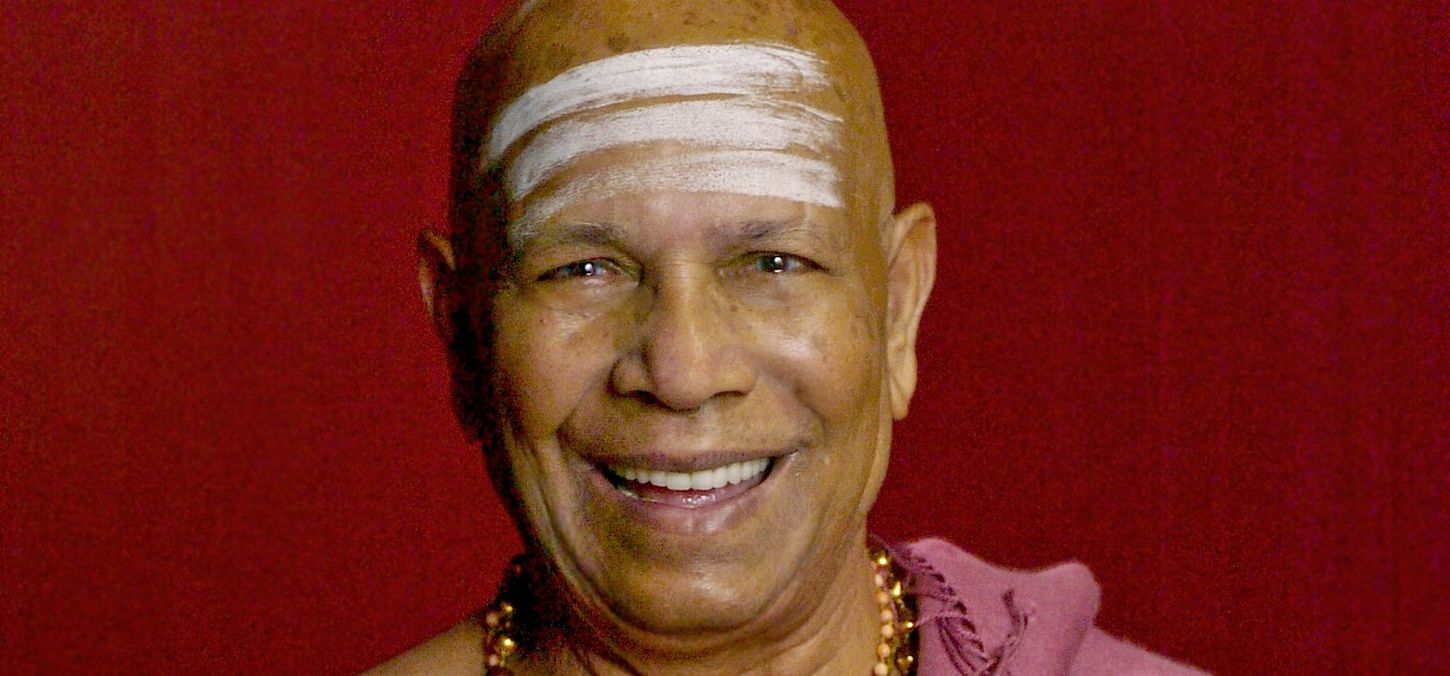

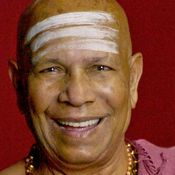
 Dr. Ronald Steiner
Dr. Ronald Steiner
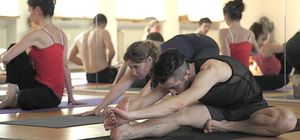
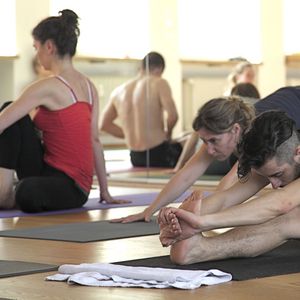
 Dr. Ronald Steiner
Dr. Ronald Steiner
